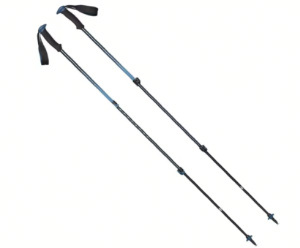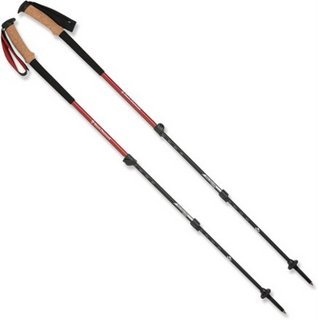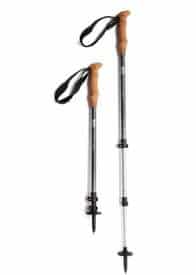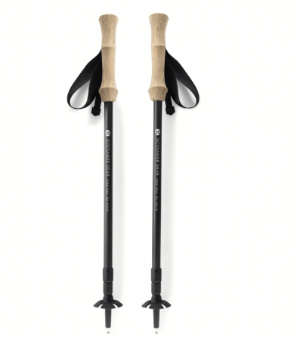
Trekking poles provide many benefits to hikers and backpackers from added stability and balance on rough trails to less wear and tear on knees and hips, especially when hiking downhill. The most popular trekking poles used by hikers and backpacks are adjustable in length, with a clamp-style lever lock adjustment system instead of twist-locks because they are more reliable and easier to fix.
Here are the top 10 trekking poles that we recommend.
| Make / Model | Material | Grip |
|---|---|---|
| Black Diamond Distance Carbon Z | Carbon Fiber | Foam |
| Black Diamond Trail Ergo Cork | Aluminum | Cork |
| Leki Cressida Cork | Aluminum | Cork |
| REI Traverse | Aluminum | Cork |
| Leki Back Series FX Carbon | Carbon Fiber | Cork |
| Black Diamond Alpine Carbon Cork | Carbon Fiber | Cork |
| Gossamer Gear LT5 | Carbon Fiber | Foam |
| Black Diamond Trail Back | Aluminum | Cork |
| Trailbuddy Trekking Poles | Aluminum | Cork |
| Pacerpole Dual Lock | Carbon Fiber | Plastic |
In recent years, carbon fiber trekking poles have become increasingly popular and have started to eclipse aluminum poles because of their lightweight. This trend has been fueled by competition from low-cost manufacturers without huge advertising and marketing budgets like Cascade Mountain Tech, Trailbuddy, Montem, and others. Some of their products are really quite good values, especially for beginner hikers and backpackers, and offer a great way to try trekking poles without breaking the bank.
If you’re still unsure about which poles to purchase, read the explanation of our trekking pole selection criteria and key considerations below. It provides a good introduction to the pros and cons of different trekking pole features and design choices. While brands like Leki and Black Diamond are much more expensive than no-name manufacturers, they really are higher quality and have very good warranties that can make them worth the price if you’re hard on gear.
1. Black Diamond Distance Carbon Z (folding)
2. Black Diamond Trail Ergo Cork Trekking Poles
3. Leki Cressida Cork Lite Trekking Poles (women’s)
4. REI Traverse Trekking Poles
5. Leki Black Series FX Carbon Hiking Poles (folding)
6. Black Diamond Alpine Carbon Cork Trekking Poles
7. Gossamer Gear LT5 Carbon Fiber Trekking Poles (ultralight)
8. Black Diamond Trail Back Trekking Poles

9. Trailbuddy Aluminum Cork Grip Poles (budget)
10. Pacerpole Dual Lock Carbon Fiber Trekking Poles
Key Considerations for Buying Trekking Poles
Here are the important features for you to consider when choosing which trekking poles to buy including pros and cons.
Price and Warranties
There is a big price difference between premium poles from Black Diamond and Leki vs less expensive off-brands like Montem, Paria, Cascade Mountain, and the dozens of other trekking pole companies you’ve never heard of on Amazon. When you buy a set of premium poles they are better quality, with tighter fitting parts, and have a stiffer feel. Black Diamond and Leki also have much more generous warranty departments and will often replace broken poles or pole segments for free, which can be a big deal if you hike a lot. The off-brands are less expensive but good for people who want to try trekking poles for the first time and don’t want to make a huge price investment. Their poles are perfectly usable for hiking, but there is a noticeable difference in durability and longevity over time.
Three-Piece, Two-Piece, Fixed Length, or Folding Poles
Most hikers and backpackers prefer three-piece poles or folding poles over two-piece or fixed-length trekking poles because they’re easier to stow when not in use. Folding poles are especially convenient for traveling although you can also pull apart three-piece poles and reassemble them when you arrive.
Lever Lock or Twist Lock Trekking Pole Adjusters
Multi-piece trekking poles are telescoping with thinner sections collapsing into thicker ones. When extended there are two main adjustment mechanisms to make them hold their desired length. Lever Locks, called Flick Locks on Black Diamond trekking poles are external clamps that fold down over the thinner section and prevent them from collapsing further. They are easy to adjust, and repair, and are very durable. Twist Lock poles rely on a plastic expander inside the poles that expands inside the thicker segment and prevents the thinner tube from moving higher. These expanders tend to wear out over time and stop working, which can be really frustrating if you’re in the middle of nowhere. We’ve used both and far prefer lever lock poles because they are so easy to care for and tighten if they loosen up. You literally tighten and external screw with a penknife or twist it tight with your fingers.
Carbon Fiber or Aluminum Trekking Poles
Many companies claim that carbon fiber poles are lighter weight than aluminum ones, or that they vibrate less, or that they’re more durable. We have seen any evidence that one material is better than another because poles made with both still break if you trap the tip between rocks or fall on them. The only advantage of aluminum is that you can usually bend them back into shape whereas carbon fiber shatters. The most important thing when deciding between the two, besides price (carbon fiber is always more expensive), is that you can buy replacement sections from the seller when you break a segment or a pole tip.
Cork Handles or EVA Foam Trekking Pole Handles
Most trekking poles come with cork handles or foam handles. Both repel moisture and provide an excellent grip. In fact, many cork poles have foam extensions under the handle if you need to lower your hands when climbing uphill. Some people will argue that cork is better because it absorbs sweat and molds to your hand over time although we’re not terribly convinced it does either. Ultimately it comes down to personal preference and price.
Shock Absorbing Trekking Poles or Regular
Some trekking poles have a shock-absorbing component, usually built into the handle or as a spring between shaft segments, that reduces the shock you’ll feel in your wrists or forearms when hiking over rock trails or asphalt. They can be very helpful to reduce the risk of repetitive stress injuries in your wrists or inflammation if you suffer from carpal tunnel syndrome or arthritis.
Ultralight Carbon Fiber Poles
Some smaller ultralight backpacking companies sell extremely lightweight carbon fiber poles that are considerably lighter weight than carbon fiber poles from Black Diamond or Leki. These ultralight poles are a lot less durable and may break frequently depending on your personal hiking style and the terrain in which you hike. For example, I have a friend who’s used the same pair of Gossamer Gear carbon fiber trekking poles for years, while I consistently broke them within a day. Just be aware that there is usually a durability difference between very thin ultralight carbon fiber poles and ones that are thicker and heavier.
Trekking Pole Baskets
The trekking pole baskets have several purposes. The small ones called trekking baskets are designed to prevent your pole tips from getting caught between rocks and broken. The wider ones called snow baskets are designed to float on top of the snow so they don’t sink in. Many pole companies don’t include snow baskets in the purchase price of their poles, even though you’d want them for snowshoeing and skiing. It’s just something to watch out for if you want poles for four-season use.
Trekking Pole Tips
Most trekking poles cope with carbide tips for hiking over bare ground and rock. It’s very difficult to wear these out and you’re more likely to break them. If either happens you want to make sure that the poles you buy have replaceable tips and that you’re able to purchase them separately. Many poles also come with rubber tips, which can be used on asphalt. These may be curved on the bottom or just bulbous rubber caps. Either type works well.
Unisex vs Gender-Specific Poles
The main difference between unisex and gender-specific poles is the length and the grip size. Men’s and unisex poles tend to be an inch longer than women’s poles and have a narrower grip because women tend to have smaller hands. Otherwise, they’re interchangeable.
Trekking Pole Tents
If you plan on using trekking poles to set up a trekking pole tent, make sure you get ones that are long enough and adjustable. Folding poles are often fixed length when expanded and may or may not be adjustable, depending on the make and model.
Check Out All of SectionHiker's Gear Guides!
- 10 Best Hiking Shoes and Trail Runners
- 10 Best 2-Person Backpacking Tents
- 10 Best 1-Person Backpacking Tents
- 10 Best Backpacking Stoves
- 10 Best Backpacking Water Filters
- 10 Best Lightweight Backpacks
- 10 Best Ultralight Backpacks
- 10 Best Backpacking Sleeping Bags
- 10 Best Ultralight Backpacking Quilts
- 10 Best Lightweight Backpacking Chairs
- 10 Best Backpacking Sleeping Pads
- 10 Best Backpacking Rain Jackets
- 10 Best Hiking Daypacks
- 10 Best Hiking Pants
- 10 Best Trekking Poles
 SectionHiker.com Backpacking Gear Reviews and FAQs
SectionHiker.com Backpacking Gear Reviews and FAQs 








I recently purchased some Black Diamond Trail Ergo Cork poles to replace a pair of REI Traverse poles (non-cork grips) where the twist locks had started to fail. So far so good, I’ve found that I really like the angle on the grips.
Those are in short supply – not sure why – but they are very popular.
They are not currently (3/20/2023) on the BD USA website, but do show up on the BD UK site.
When I started hiking more seriously I bought a couple pairs of the Trailbuddy poles. For what they are – it’s good value. The lock adjustment can be finicky and not everything is made with stainless steel (there is some surface rust on parts) and the wrist strap can be a pain to adjust. If you buy multiple pairs buy all the same color so if/when one fails it’s seamless to mix-n-match. I keep them around now in case I go out with other “non-hikers” if they want to try them.
Moving from the Trailbuddy went to the BD Ergo’s simply because of the angled grip which makes a much bigger difference than one would think just looking at them (I’m sure Pacer’s are similar!).
Exactly. In these gear guides I think it’s important to recommend some entry-level and more affordable options for people dipping their toes in our sport/hobby. But there really is a difference in quality and design when you move to the more expensive brands.
In addition to considering length for trekking pole tents, I would encourage hikers to consider poles that expand to a length greater than what would be their regular fit. The reason for this is for water crossings. When standing on a tree limb over the water, or rocks in the water, the additional length can be a big help in getting you safely across.
Phil, do you find there is any difference between cork handles and EVA handles when it comes to rodent chewing? Do the “mini-bears” prefer one over the other?
I’ve never had that problem. I would assume that they’d prefer cork because it actually absorbs perspiration while the EVA probably doesn’t.
I had mini bears eat the grips on a pair of Black Diamond ergo cork poles last Summer in the Sangre de Cristo mountains in New Mexico. They did far more damage to the plastic around the cork than the cork itself, fwiw
if anyone’s looking for a great quality:price value point then the Fizan Compact 3’s are fantastic. highly recommend, especially if all your using them for is to keep up an XMid or something like that.
They’re ok. Twist locks. I reviewed a pair many years ago when the DROP still promoted outdoor products.
yep, I remember that. I’d say imo a better budget choice over the trailbuddy ones. I also like the twist lock over the snap because I’ve had issues – especially with folding types – of having a pair that fits my height (5’7″) while also being tall enough to support the aforementioned kind of tents.
also, what’s your personal preference of carbon or aluminum? I’ve found the aluminium more dependable than carbon.
Carbon vs Aluminum. It really depends on the pole and how you use it. Some carbon fiber poles are thicker than others and therefore more reliable, but if you fall just right, you can snap both types. It also depends on whether you use snowbaskets or straps. For example, I use a CF pole, no straps, and snow baskets all year round. The lack of straps means I can release the pole if I fall so it won’t snap or break my wrist. The snowbaskets prevent me fron sticking the pole tip into a hole and breaking the pole. Then again, I’d probably do the same things with an aluminum pole. So, net net. It doesn’t really matter all that much what its made of but how you use it.
Helinox poles didn’t make the cut I see. I have a pair and really like them. The locks are hard to beat when you are packing out 75# more than you went in with
Black Diamond Trail Ergo Cork Trekking Poles are one of my gear. I love this because it’s adjustable.
I just picked up my second set of Cascade Mountain Tech carbon fiber poles at Costco for $35. They have lever locks and cork handles and I think they’re an outstanding value. I recently completed the Sheltowee Trace with the first pair and never had an issue. I didn’t need the second set, but for the price, I felt I couldn’t pass up having a spare set in case I break one or a friend needs a set.
I have a set of BD Trail Ergo and a set of Cascade Mtn Tech from Costco. I really like both. I use poles daily, and I choose based on my mood. They probably get about equal use.
I had a pair general Leki aluminum poles with cork grips and anti shock and I liked them until I tripped one day and caught myself with poles. Unfortunately being over 225lbs and close to 300lbs in winter with a full pack I quickly realized that the poles would not support my weight and I broke them. I realize that they are probably not intended to support people’s full weight but in the winter especially descending some icy areas or crossing water I often rely on that support. I went to the store and tried out some new poles. If I extended a normal pole and put an open palm on top of the pole and pushed down (without leaning on it) I was able to bend the pole (I did not purposefully break them in the store but I am confident that I could have) I called Black Diamond and Leki and asked if they had any recommendations. Both told me that their carbon ones would not be any stronger. BD essentially suggested one of their most popular version and told me a could buy replacement pieces when I broke them. Leki it turns out sells what they call a mountaineering/four season pole. They have some which have a larger diameter aluminum shaft than the regular Leki or BD poles. I ordered the “Sherpa” model and have used them this past winter and have been very pleased. I am sure they are heavier but I feel much more secure and confident with them. They are certainly not indestructible but I am not able to bend them just by pushing down on them and I can lean on them without worry of them breaking.
The other suggestion would be a standard ski pole. Yes, you’ll lose the ability to collapse them and they’re heavier and all that stuff but a ski pole has much more strength.
That is a very good point. They can be much stronger and I have tried them. I prefer being able to adjust the length shorter on the ascent and longer on the steep sections going down. Ski poles are a great idea though and much cheaper if you already have them.
REI sales coming up, looking at Aluminum poles:
REI Traverse poles vs new BD Pursuit poles – are BD poles worth the extra money?
No. The added word “Pursuit” isn’t worth the incremental cost.
Suggest looking at availability of parts (buying sections that you might break). Friend has/had a pair of REI Carbon poles, snapped a section and found out REI does not sell replacement sections so the whole pole is trash. BD historically good about “parts”. Agree with Philip though that if all they’ve updated is a name, that’s hardly justification over a lower model.